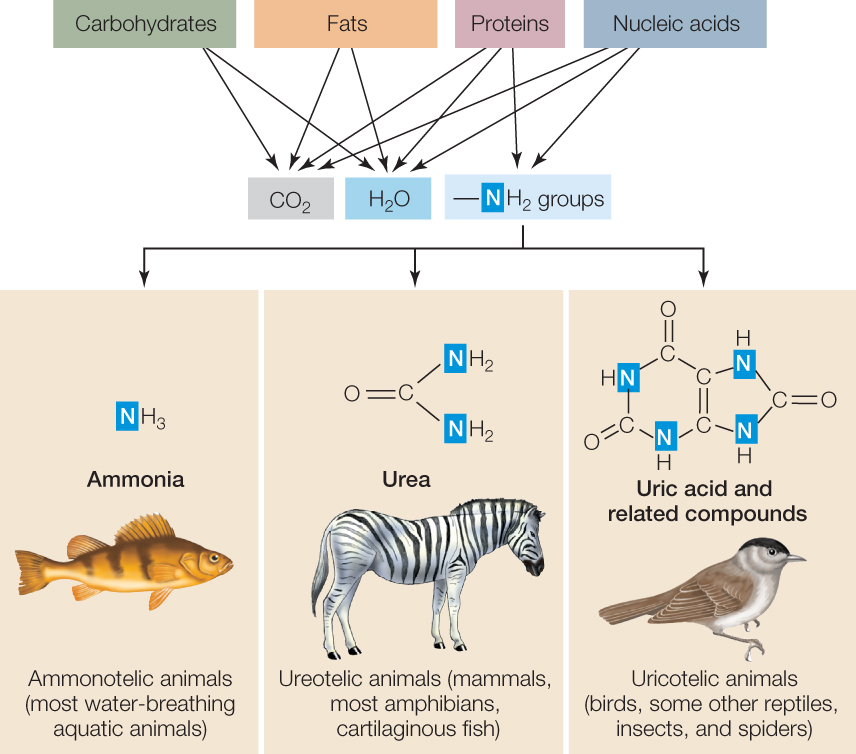CONCEPT36.2 Nitrogenous Wastes Need to Be Excreted
When carbohydrates and fats are fully broken down during metabolism, the end products of the process are H2O and CO2 (see Concept 6.2), which are not difficult to eliminate. Proteins and nucleic acids, however, contain nitrogen atoms. Their breakdown therefore produces not only H2O and CO2 but also nitrogen-containing waste molecules termed nitrogenous wastes. These molecules can be toxic, creating special challenges.
Kidneys are occasionally defined as the organs of nitrogen excretion. This is a misleading definition because in fact the chief function of kidneys is regulation of the blood plasma. Moreover, whereas the kidneys are important in nitrogen excretion in some types of animals, they play little or no role in nitrogen excretion in many other types.
Most water-breathing aquatic animals excrete ammonia
During the breakdown of proteins and nucleic acids, nitrogen atoms are removed from the molecules in the form of amino groups (—NH2), as shown near the top of FIGURE 36.4. The —NH2 groups are easily converted to ammonia (NH3) or ammonium ions (NH4+) without any investment of energy. Ammonia therefore is the simplest and energetically cheapest nitrogenous waste to produce. The problem with ammonia is that it is highly toxic, and its concentration must be kept very low in the body fluids.

Crayfish, squid, most fish, and most other water-breathing animals excrete nitrogen principally as ammonia and for this reason are called ammonotelic. They are able to use ammonia as their principal waste because they can lose it rapidly and directly into their aquatic environment across their outer body surfaces. Ammonia is highly soluble in water and diffuses rapidly, so it can be lost readily across the gills and other permeable body surfaces as fast as it is produced, keeping internal concentrations low.
Most terrestrial animals excrete urea, uric acid, or compounds related to uric acid
Terrestrial animals typically must void nitrogenous wastes in their urine. Ammonia is so toxic that great volumes of urine would be required for it to be lost in the urine. The loss of water in urine would in fact be great enough to be dehydrating. Because of all these constraints, terrestrial animals almost never excrete nitrogenous wastes primarily as ammonia.
Instead, terrestrial animals incorporate waste —NH2 groups into compounds that are far less toxic than ammonia. Producing these compounds requires ATP and thus has a metabolic cost. This is a disadvantage. However, the compounds have the advantage that they do not need to be excreted immediately. Their toxicity is low enough for them to be concentrated in the urine before they are excreted, reducing the amount of water required to excrete them:
- Mammals and most amphibians excrete waste nitrogen principally as urea and therefore are called ureotelic (see Figure 36.4). Urea is very soluble and relatively low in toxicity.
- Insects, spiders, and many reptiles (including birds) are uricotelic, meaning they excrete waste nitrogen mainly as uric acid or compounds related to uric acid. These nitrogenous wastes are poorly soluble in water and thus are often excreted in precipitated (solid or semisolid) form. Precipitation removes the compounds from solution, reducing their toxicity and the amount of water needed to excrete them. The whitish paste in bird droppings is uric acid.
Animals that live in different habitats at different developmental stages may change their primary nitrogenous waste when they change habitat. For example, the aquatic tadpoles of frogs and toads excrete ammonia across their gill membranes, whereas adult frogs and toads generally excrete urea.
CHECKpointCONCEPT36.2
- Name the three major nitrogenous wastes. Which one is the most toxic?
- Desert-adapted species of mice and rats survive in deserts by minimizing their water losses. Most are herbivores: they eat mostly plant foods. Why might a desert mouse or rat tend to be dehydrated by eating a large meal of animal flesh?
- Some species of amphibians that live in arid or semiarid habitats excrete uric acid as adults, instead of urea as other adult amphibians do. What selective advantage would this adaptation have had for the early ancestors of these species?
Now that we have reviewed the three forms in which nitrogenous wastes can be excreted, let’s focus on the challenges that animals face in Earth’s major environments. We’ll start with the aquatic environments: the ocean and bodies of fresh water such as lakes and rivers.